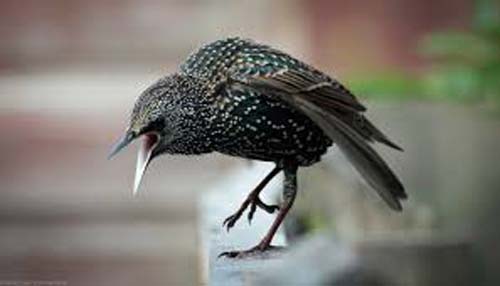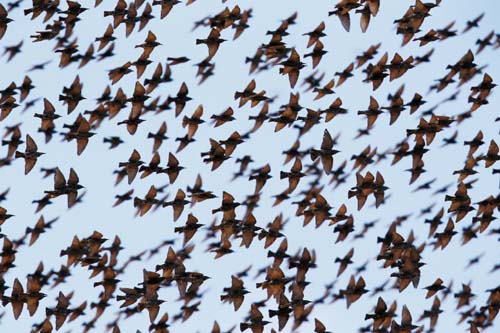
Rome’s starlings: Kinetic artists or urban pests?
Martin Bennett
Rome: Like every year since 1925-26 they’re back. Four million by one count. Stormi di storni. Flocks of starlings. And with navigation skills to make Christopher Columbus seem amateur, “storm” is just what they do, above Euro Palasport, along Lungotevere, above Stazione Tiburtina and Piazzale della Radio to name four of their favourite haunts.

One minute these most highly-organised and gregarious of birds adorn the sunset, flexing their claim to be the planet’s most consummate kinetic artists, split-second Calders and Kandinskys, sky-scrapering Jackson Pollocks. (Strength in numbers: the bigger the flock, the more likely a member will locate any nearby predator and alert the others.)
The next minute, like a supersize djinni back into his lamp, they are funnelling with pinpoint accuracy into a handful of trees which then start to throb beneath the weight. Dormitori collettivi, is the experts’ term – and how! At least as long as their leaves permit. Viale Trastevere’s planes are particularly overbooked, as in previous years, while the starlings have largely abandoned the Stazione Termini following the recent pruning of the area’s ilex trees.
Arrival time is typically about half-an-hour before sunset. This is after a day’s gorging on insects, grains and even animal fodder, all over an area estimated as being as wide as 80 km. (Starlings are notoriously omnivorous; according to one study up to 5 per cent of Italy’s entire olive production disappears down their throats – equally a daily rate of 10 olives per bird. Likewise for cherries, grapes, maize, name your food source.) Come dusk, back in their tree hotels, they can recover energy and rest their metabolisms. Obeying their own pecking order, the heavier alpha males hog the cosier central part of the tree.
So far so good. Now the downside. Birds, starlings one might say in particular, have no bladder; the same organ was dispensed with by evolution to lighten body-weight. Nature, that best of best engineers, also arranged for a wafer-thin liver and hollow bones to impart a further aerodynamic edge. Hence, wherever they congregate, mingling with city’s petrol fumes come industrial amounts of acrid-smelling guano. A recent letter to Italian daily La Repubblica complains that neither is Verano cemetery spared, cypresses being another of the bird’s favourite trees. Along Lungotevere the same substance often proves a peril for motorcyclists and pedestrians; guano mixed with feathers, rotting leaves and motor oils is skiddier than the slipperiest soap.
One estimate has the aptly-named sturnis vulgaris producing 40 grams of guano daily, putting the species up (or down) there with the pigeons in Venice’s S. Marco Square, which can together produce a ton in the same time span.
And solutions? The main problem is numbers. In Italy these are reckoned to have doubled in the last decade. In the US, 120 starlings were introduced in the 1890s in New York’s Central Park; by 1950 they’d multiplied a million times and are the US’s most populous species. Back in Rome, one tactic has been to invite a father and son team of falconers from Latina where their five Harris (Texan) falcons are normally used to scare seagulls from rubbish tips.
One might argue that this is only to shift the problem to another district. Faced with starling numbers, the most colossal scarecrow – another solution posited – could become discouraged. Starlings with their intelligence grow accustomed to this repellent as well. As they do to so called dissuasori sonori, sound devices, the most ingenious of which amplify, via recordings, the starlings’ own distress call.
Add to the list fireworks, and in parts of rural France dynamite. This not to mention poisons, and then detergents air-sprayed onto the birds’ dormitories to wash away the protective oils in the birds’ plumage and so induce hypothermia. Crying fowl, forgive the pun, animal rights activists have predictably risen to the birds’ defence. Against such measures is also the fact that by killing off even as much as 10 per cent, the others’ food supply goes up, lengthening their lifespan, until numbers can increase further. Less complicated is simply pruning the birds’ favourite trees. Such as, this year, those of Piazza dei Cinquecento outside Termini and Piazza Benedetto Cairoli near Largo Argentina; last years’ bird-hotels are now a few spindling and empty stumps with, so far at least, not a speck of guano in sight. Problem solved? Visit Stazione Tiburtina and there the birds throng instead.
Meaning, perhaps, if you cannot beat them, join them, at least in a spectator capacity. Up with the Colosseum or St Peter’s, their air shows are one of the wonders of Rome. Now with wonder, now with a pinch of apprehension, read into their synchronised aerodynamics what you will. To this sometime language teacher, they spell impromptu alphabets plus pulsing punctuation marks, multi-colons, “questamation” marks, mostly beyond our comprehension. To Pliny the Elder they conjured a sort of ball gravitating toward its own centre (Naturalis storia). To Italo Calvino, via his Signor Palomar, they are “An aerial mob which seems on the point of dispersing like dust-grains suspended in liquid, only to grow denser as if invisible conduit continued to add swirling particles without ever saturating the solution.”
And how do they avoid bumping into one another? Making us humans with our daily traffic jams seem distinctly retarded, one starling changes direction and a fraction of a second later their immediate neighbours follow suit, no hapless traffic warden needed. One study states the birds’ reaction time as being 13 times faster than our own, while another attributes the birds with the ability to count up to seven.
All the sky their stage, let us be groundlings to the spectacle. A year ago they featured in a video-artist’s exhibit in the Casa di Goethe on Via del Corso, though they are far more impressive in real life than on a tiny screen. Compared to their talent for shape shifting – high-flying carousel or military manoeuvre (Calvino again), or dance of the seven veils to the umpteenth power, a feathered cloud – the most exuberant Aeropittura of the Futurists seems almost static. Look up then; puzzle and admire, but remember to carry an umbrella.
